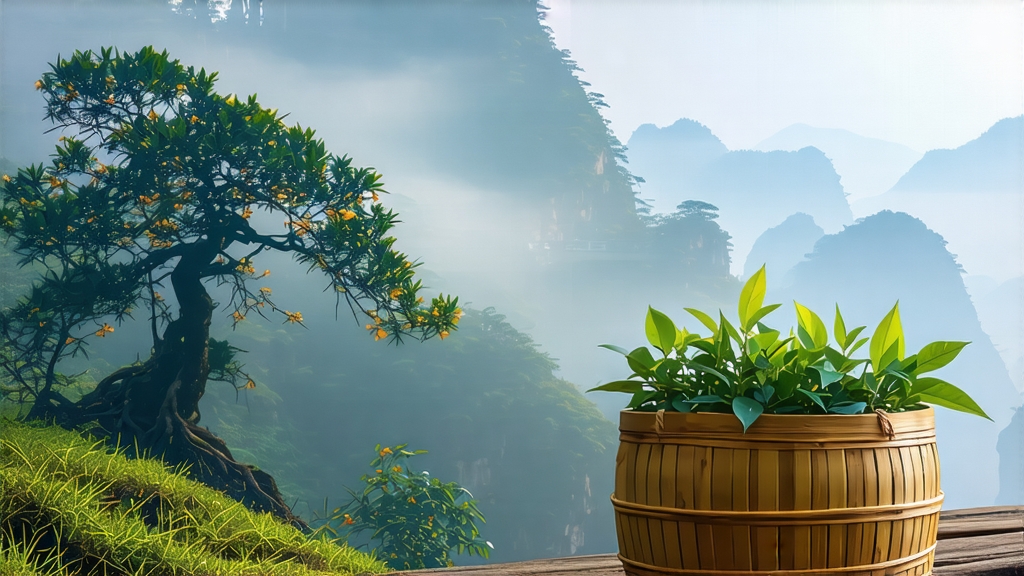
Tucked high above the Sichuan basin where perpetual cloud drifts across knife-edge ridges, Meng Ding Huang Ya has been quietly turning emperors into poets since the Tang dynasty. Western tea catalogues often relegate yellow tea to a footnote between green and oolong, yet this single-bud pluck from the legendary Meng Ding Shan demonstrates why the category once commanded more silver than top-grade Long Jing. To understand it is to step into a six-century story of monks, merchants, and microbiology that still unfolds in the cool dawn of each April.
History: from altar to imperial altar
Buddhist monks planted the first tea gardens on Meng Ding (“Fertile Summit”) around 800 CE, choosing the 1,450 m elevation where morning mist blocks ultraviolet light and slows photosynthesis, concentrating amino acids in the tiny spring buds. By the Song dynasty the leaves were pressed into cakes, steamed, and sent to Kaifeng as temple tribute; when the Ming court abolished compressed tea in 1391, local artisans invented the loose-left “yellowing” process to differentiate their gift. The Qing Qianlong Emperor so adored the honeyed liquor that he exempted Sichuan tea caravans from transit tax, a privilege inscribed on a stele still standing in Ya’an. After 1949 the gardens were collectivised, yellowing halls fell into disrepair, and Meng Ding Huang Ya survived only because a few elderly craftsmen hid baskets of buds inside rice-warming stoves during the Cultural Revolution. When China reopened, Japanese buyers seeking low-caffeine, high-theanine teas rediscovered the mountain; today 800 families produce barely 12 tons a year, 70 % of which never leaves the country.
Micro-terroir: why the buds turn golden
Meng Ding Shan sits at the collision of the Sichuan basin’s humid air and the Tibetan plateau’s cold downdrafts. The result is 220 foggy days annually, 85 % relative humidity, and a diurnal swing of 10 °C—conditions that encourage a mutant flavonol synthase gene in the local Xiaoye zhong cultivar. The enzyme oxidises catechins into yellow-pigmented theaflavins without the leaf trauma typical of black tea, so the bud stays intact yet changes colour. Soils are Devonian sandstone leached by constant drizzle, yielding a potassium-rich, slightly acidic profile that pumps L-theanine to 4.2 %, double the level of most green teas and the source of the famous “umami broth” note.
Pluck: one bud, one dew, one breath
The harvest window opens when the Chinese red-billed leiothrix begins to sing at 5:30 a.m., roughly ten days before Qingming. Pickers climb 300-year-old stone staircases carrying bamboo tubes lined with fresh banana leaves; they pinch the terminal bud plus the half-unfolded first leaf, a standard called “sparrow’s tongue” that must weigh 0.3 g wet. Anything larger is rejected because the yellowing step demands uniform moisture gradient—an extra millimetre of stem would ferment unevenly and produce the dreaded grassy edge.
Craft: the confidential 48-hour “sealed yellowing”
Within thirty minutes of plucking the buds are spread on goat-hair trays and wok-fired at 85 °C for three minutes, a kill-green phase that sets the jade colour and arrests polyphenol oxidase. While still at 40 °C the leaves are hand-rolled 18 times along the bud axis to break exactly 12 % of cell walls—too little and yellowing will not initiate, too much and the leaf blacks like oolong. The critical innovation is the “men huang” (sealed yellowing): the warm leaves are piled 5 cm deep inside linen bags, then slid into a pine-wood cabinet lined with wet rice paper. The cabinet is closed and left at 28 °C with 80 % humidity for 24 hours; anaerobic microbes bloom, converting citric acid into malic acid and releasing a faint pineapple aroma. Artisans open the bags every eight hours to flip the pile, judging readiness by the colour shift from jade to pale topaz and the appearance of tiny golden hairs that sparkle under torchlight. A second low-temperature firing at 60 °C for 90 minutes fixes the colour and drops moisture to 5 %. The entire cycle must finish within 48 hours; delay by even half a day and the tea slips into sourness.